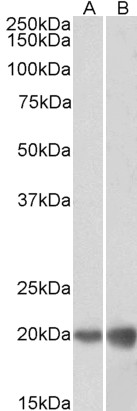
The image on the left is immunohistochemistry of paraffin-embedded Human brain tissue using CSB-PA926314(DUT Antibody) at dilution 1/30, on the right is treated with synthetic peptide. (Original magnification: x200)
DUT Antibody
CSB-PA926314
ApplicationsWestern Blot, ELISA, ImmunoHistoChemistry
Product group Antibodies
ReactivityHuman, Rat
TargetDUT
Overview
- SupplierCusabio
- Product NameDUT Antibody
- Delivery Days Customer20
- ApplicationsWestern Blot, ELISA, ImmunoHistoChemistry
- CertificationResearch Use Only
- ClonalityPolyclonal
- ConjugateUnconjugated
- Gene ID1854
- Target nameDUT
- Target descriptiondeoxyuridine triphosphatase
- Target synonymsBMFDMS, dUTPase, deoxyuridine 5'-triphosphate nucleotidohydrolase, mitochondrial, dUTP diphosphatase, dUTP nucleotidohydrolase, dUTP pyrophosphatase
- HostRabbit
- IsotypeIgG
- Protein IDP33316
- Protein NameDeoxyuridine 5'-triphosphate nucleotidohydrolase, mitochondrial
- Scientific DescriptionThis gene encodes an essential enzyme of nucleotide metabolism. The encoded protein forms a ubiquitous, homotetrameric enzyme that hydrolyzes dUTP to dUMP and pyrophosphate. This reaction serves two cellular purposes: providing a precursor (dUMP) for the synthesis of thymine nucleotides needed for DNA replication, and limiting intracellular pools of dUTP. Elevated levels of dUTP lead to increased incorporation of uracil into DNA, which induces extensive excision repair mediated by uracil glycosylase. This repair process, resulting in the removal and reincorporation of dUTP, is self-defeating and leads to DNA fragmentation and cell death. Alternative splicing of this gene leads to different isoforms that localize to either the mitochondrion or nucleus. A related pseudogene is located on chromosome 19.
- ReactivityHuman, Rat
- Storage Instruction-20°C or -80°C
- UNSPSC41116161







